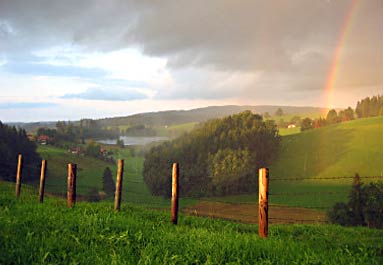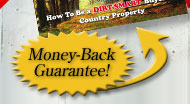This original column is provided free for one-time use with author credit at the end. It may be used for background with author credit. Copyright applies.
#66 FOR IMMEDIATE RELEASE: December 18, 2008
Land ownership helps rural economic development: Can we Land a Hand?
By Curtis Seltzer
BLUE GRASS, Va.—Land has always been involved in what we now call, rural economic development.
Those who owned no land in rural communities were almost always poor. The larger the landholding, the more prosperous the owner was likely to be.
The desire for land and its resources motivated European settlement to the New World, and the expected benefits of land ownership lay behind America’s westward expansion.
Cheap land was the stimulus that drove American settlement and economic growth for 250 years. Communities grew in step with the degree of diffused ownership.
As our economy shifted from farming to manufacturing to services, new growth engines came into play. But in rural areas, land ownership continues to be a ladder for individual betterment. And to the extent that it’s “spread around,” in Barack Obama’s words, communities benefit.
In the 40 years that I’ve watched public efforts to promote rural economic development, I’ve never seen much focus on encouraging land ownership by lower-income individuals. The preferred strategies invested in public infrastructure (highways, water and sewerage systems, communications) and public intellectual capacity (planners, agencies), and provided public capital (loans, tax breaks, buildings, subsidies and labor training).
The idea behind these traditional approaches has been to make it economically worthwhile for businesses to invest in rural areas that they would otherwise avoid. The same general approach has also been applied in inner cities.
These approaches have had a mixed record of success. Generally speaking, counties and communities that start out with more location advantage and resources do better with public programs than the most deeply distressed places. The poorest, most rural and most damaged remain “zones of repugnance” to most private capital.
Rural communities that have the farthest distance to climb up the ladder are the ones that, as a rule, have climbed the slowest and gone the shortest distance with public development investments. Many are places where much of the land is held by a few corporations, individuals or public agencies.
Many rural areas have economies that are increasingly reliant on tourism and second homes. Both bring outside money in, but both have downsides. As economic-development strategies, each embraces the idea that a dollar spent at an upper level of a community’s economy eventually dribbles pennies down through the ones below.
The truth about trickle-down strategies is that they most benefit those closest to where the outside money is injected. Most dollars stick where they start, which should come as no surprise.
The rural poor who I’ve seen move up economically always combine individual resources like ambition or intelligence with a hand up or a break. Communities that have improved themselves followed the same formula.
Democrats being Democrats, they will soon offer “program initiatives” to lessen poverty and strengthen rural communities. Suits me.
So here’s a modest idea that for lack of a better name, I’ll call, Land a Hand.
It’s pretty simple. Make land available for acquisition in small chunks to low-income rural people.
Where might this land come from? Private landowners could donate it to a land bank in return for a 100 percent (or higher) credit taken against taxable income, useable over five years. Timberland companies might be interested in doing this when they could reserve the timber for some number of years. Strip-mined land would do just fine.
Some public land might also be made available. Many federal and state agencies hold marginal lands that are not vital to their commercial, recreational or environmental functions.
A third source of land would be foundations that could buy large tracts.
The non-profit land bank would work out lease-to-own or sale terms with individuals who meet established lower-income criteria. The bank would make purchases workable, customizing terms to fit the individual’s resources. Sweat equity, in the manner of Habitat for Humanity housing, should be incorporated into individual acquisition plans.
The program should be accessible, but protected against abuse. An acreage cap should be set, and resale should be prohibited for some period of time. Loan terms should be set up to allow these subprime borrowers to succeed, not fail.
If timbering is anticipated, it should conform to a bank-approved, forest-management plan. A proportional part of timber-sale income should be paid on the mortgage. Property could be improved with buildings; it could be leased, used as collateral and, at some point, mortgaged. It could be left as is, used for hunting and recreation or dedicated to some environmental purpose.
Local non-profits might also be included as a way of building their asset and income base to promote community development.
Land a Hand would bring economically orphaned individuals back into the flow of their local communities. It would create assets with folks who generally don’t have many. The benefits and responsibilities of property ownership would help lower-income individuals just as they do wealthier ones.
Land a Hand would build communities from the bottom up.
It would provide individual opportunity and not cost taxpayers very much
Land a Hand is an idea that’s worth a try.
Curtis Seltzer, land consultant, is the author of How To Be A DIRT-SMART Buyer of Country Property at www.curtis-seltzer.com. He holds a Class A residential contractor’s license in Virginia and has lived in a now 90-year-old farmhouse for 25 years.
Contact: Curtis Seltzer, Ph.D.
Land Consultant
1467 Wimer Mountain Road
Blue Grass, VA 24413-2307
540-474-3297
curtisseltzer@htcnet.org
www.curtis-seltzer.com
This original column is provided free for one-time use with author credit at the end. It may be used for background with author credit. Copyright applies.
|









